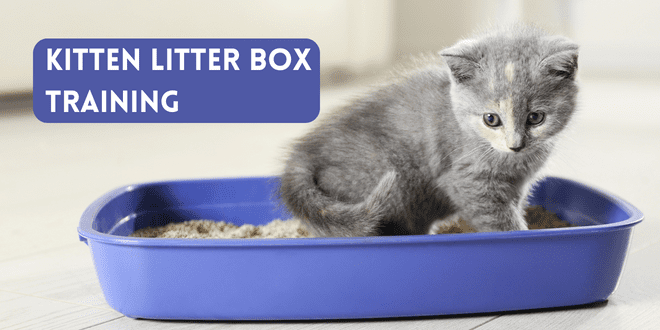
Unless you’ve rescued an orphaned kitten who is still in the bottle-feeding stage, chances are you won’t have to teach the furry little one how to eliminate but you will have to create a litter box set-up that’s conveniently located and easy to enter and exit. You will also have to provide guidance and help your kitten with timing. Some kittens get the hang of the litter box right away and others need more hand (paw) holding. Just don’t assume kittens come pre-programmed to know where all the pee and poop belong. They need your help!
A Box Fit for a Kitten
As the kitten grows, he’ll appreciate having a big box with lots of room, but for now, the litter box set-up needs to be kitten-friendly. The box should be easy for a young kitten to get climb in and out. A high-sided box will be too difficult for a youngster to crawl over, especially with a full bladder. Keep in mind a kitten won’t have the bladder control of an adult cat so when he has to “go” it’s usually urgent.
Choose a low-sided box initially. This will not only help in terms of being able to get into it, but also, if the kitten can see the litter, it may serve as an added reminder. Seeing the soft substrate may remind him this is the place to dig, eliminate and cover waste.
As the kitten gets older you can then place a larger box next to the smaller one to start a gradual transition. You can even place the smaller litter box inside the larger box to get your kitty used to the new set-up.
Never use a covered box or an electronic box with a kitten. The box set-up should be convenient, safe, simple, quiet, and hard to miss.
The Litter Choice
There are many types of litter on the market but in general, the best choice for a kitten is one of the soft, scoopable types. A texture that resembles sand on the kitten’s paw pads will be much more comfortable and will make it easier to dig and cover. It’s also more comfortable for your kitten when squatting in elimination position. Standing on traditional clay litter that has some sharper edges or hard crystal-type litter may not be as comfortable for a kitten who is just learning the ropes when it comes to bathroom etiquette.
To Clean or not to Clean
With an adult cat you would hear me telling you over and over again to keep the litter box conditions absolutely pristine. With a kitten though, it’s a good idea to leave a little (notice, I said “a little”) liquid or solid waste in there. This will help serve as an added reminder of where the pee and poop go.
If you find a little solid waste outside the litter box, instead of tossing it in the toilet, place it in the litter box so your kitten will have a little scented reminder of where it should’ve been placed.
Litter Box Location
For a kitten, the box needs to be really, really easy to find. Kittens don’t have great bladder control so you shouldn’t expect your new youngster to be able to get all the way across the house or down a flight of stairs to find the box.
Confine your young kitten to a smaller portion of the house so he can easily get to the litter box. Once your kitty starts having access to more of the house, place litter boxes in multiple locations.
Litter boxes should be in open areas where the kitten can easily see them. They should also be in quiet areas so he isn’t easily distracted. The location should be safe and secure so he doesn’t have to worry about the family dog sticking a nose in there or a child or other family member startling him.
Help Remind Your Kitten
Typically, cats may eliminate after a nap, after playing or after eating. Your kitten will probably be on that schedule and then some because he’ll need to eliminate more frequently than an adult cat. Frequently bring your kitten over to the litter box on a regular schedule as he learns to perfect potty timing. Never force your kitten into the box.
When You Need to be the Mother Cat
If your kitten isn’t getting the whole dig, eliminate and cover routine, or if he was taken from the mother too young and didn’t get that lesson, you’ll have to assist. When you bring your kitten over to the litter box for a potty break, use your finger and dig a little in the litter. The sound and sight of that might entice your kitten to do the same. If kitty eliminates but doesn’t cover it, take your finger and cover it a bit so he can see the sequence, DON’T take your kitten’s paws and cover the waste. That will only cause him to pull away and can start you off with potential litter box aversion. Just let kitty see YOU do the covering.
Never Punish for Out-of-Box Accidents
Your kitten is just learning and may not make it to the box in time. Don’t punish in any way for missed litter box attempts. Instead, look at what you might be able to do to make it easier next time. Perhaps your kitten was playing too far away from the box and you didn’t bring him back for a potty break in time. Maybe the box is too hard to get into? Was someone in the family holding the kitten for too long while he was squirming to get away in order to get to the box? Litter box accidents aren’t the kitten’s fault. Any punishment will only start to create a fear of you (not what you want when you’re establishing a new relationship) and potentially cause a litter box avoidance problem.
Need More Information?
For more specific information on training a young kitten to the litter box or more information on raising a well-adjusted kitten, refer to the best-selling books by Pam Johnson-Bennett. Pam’s books are available at bookstores and online. We’ve included Amazon links here on our website.
If you have a question regarding your cat’s behavior or health, please contact your veterinarian. This article is not intended as a replacement for your cat’s veterinary care. This article is for information purposes only and not offering medical advice or providing a medical diagnosis.




